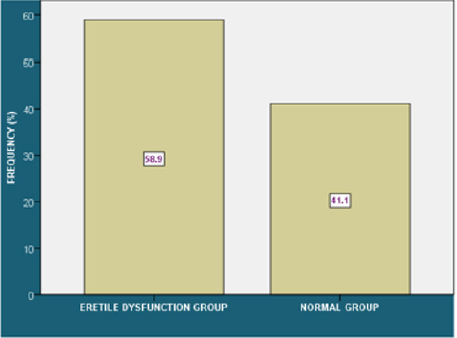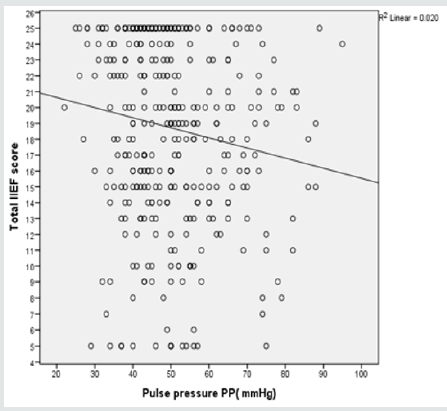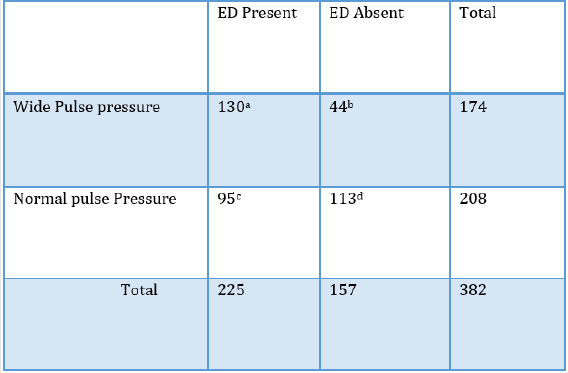
Lupine Publishers Group
Lupine Publishers
Menu
ISSN: 2641-1687
Research Article(ISSN: 2641-1687) 
A study of Pulse Pressure as a Measure of Erectile Dysfunction Among Men in Ndola, Zambia Volume 2 - Issue 4
Geoffrey Chitambala1 and Kasonde Bowa2*
- 1Registrar, Copperbelt University School of Medicine, Zambia
- 2Professor of Urology, Copperbelt University School of Medicine, Zambia
Received: February 12, 2020; Published: February 20, 2020
Corresponding author: Kasonde Bowa, Professor of Urology, Copperbelt University School of Medicine, Ndola, Zambia
DOI: 10.32474/JUNS.2020.02.000145
Abstract
Introduction: Erectile Dysfunction is an increasing problem in developing countries. Studies have shown a prevalence of up to 45% among men of 45 years and older [1]. Erectile Dysfunction (ED) is related to the integrity of the arterial endothelium [2]. The Pulse Pressure (PP) is a good measure of the calibre of the arterial blood vessels. It is a sensitive predictor of cardiovascular events in ageing populations. In view of this, the study proposes the use of Pulse Pressure in predicting Erectile Dysfunction in ageing men.
Objectives: The objective of this study was to determine the accuracy of Pulse Pressure (PP) in predicting Erectile Dysfunction (ED) using the International Index of Erectile Function Score (IIEF5) in men aged 45 years and older at Ndola Teaching Hospital in Zambia.
Methods: The study was a cross-sectional study which recruited healthy men who were 45 years and older in Ndola, Zambia. The study compared the Pulse Pressure (PP) of men to the status of their sexual function based on the International Index of Erectile Function Score (IIEF5). The IIEF5 was categories into two groups. These groups were group 1 with Erectile Dysfunction (ED) and group 2 without Erectile Dysfunction. Those with IIEF5 score of 21 or less were defined as having ED, while those with IIEF5 score of 22 to 25 were defined has having no ED. Pulse Pressure of equal to or greater than 50mmHg was defined as a wide pulse pressure. While that of less than 50mmHg was defined as a normal Pulse Pressure. SPSS version 20 was used for data entry and analysis. The sensitivity, specificity, and correlation coefficient were used to compare the results obtained. Sensitivity was defined as the ability of the wide PP to detect an IIEF5 score of 21 and below. Whereas Specificity was defined as the ability of the normal PP to detect an IIEF5 score of 22 and above.
Results: We recruited 382 men with an age range between 45 and 91 years. The mean age was 54.9 years (standard deviation ± 9.73 years). The IIEF5 score showed that 158 men (41.4%) had no ED, and 224 men (58.6%) had ED. While, the PP was normal in 205 men (53.7%) and wide in 177 men (46.3%). The sensitivity of the PP to detect ED was 58.9%, and the specificity was 72%. This study showed that in our setting, PP can be used to screen for ED in men of 45years old and above.
Introduction
The prevalence of Erectile Dysfunction (ED) in men in Zambia
has been reported at 62% [3], this is believed to increase with age.
The risk factors for ED include age, Hypertension, Diabetes and
a high Body Mass Index (BMI). The prevalence of Hypertension
in Zambia ranges between 25 to 40% [4], while the prevalence
of Diabetes is at 3.5 to 6% [5]. In clients who are Diabetic, or
Hypertensive the ED prevalence has been reported to be as high
as 85% [6].
The tool which is used to assess Erectile Function is the
International Index of Erectile function Score (IIEF), which was
modified in 1999 by Rosen [7]. It assess 5 sexual function parameters
and scores them from 1 to 5. The score is a well validated measure
of sexual function. Pulse Pressure is the difference between the
Systolic and Diastolic Blood Pressure. The Pulse Pressure is a
sensitive measure of vascular function. With ageing lipid materials
are deposited in the sub intimal lining of arteries and this results in
narrowing and stiffness of the vessels. This leads to a widening of
the Pulse Pressure, because of an increase in resistance and a loss
of vessel compliance. The physiology of Erection is dependent on
rapid arterial inflow which leads to compression of venous outflow.
It has been shown that a wide pulse pressure increases the risk of Cerebrovascular Accident (CVA), Myocardial Infarction (MI) and
Peripheral Artery Disease (PAD) [2]. Little literature is available on
the relationship between Pulse Pressure and Erectile dysfunction.
The study objective was to determine the accuracy of Pulse
Pressure to predict Erectile Dysfunction in men of 45years and
older.
Methods
The study was performed in a Men’s Clinic set up in the
outpatient department of the Ndola Teaching Hospital. The case
definition was any male patient aged 45 years and older in general
good health.
The participants were consented, and three blood pressure
readings were taken using an electronic Sphygmomanometer.
The average reading was taken as the Blood pressure and used
to compute the Pulse Pressure. A Pulse Pressure greater than
50mmHg was defined as wide, and PP of 50mmHg and less was
defined as normal.
The study tool the International Index of Erectile Function 5
(IIEF5), was administered to participants by researchers. Words
that the participants found difficult to understand were explained
in the local language. The IIEF 5, has five questions which are scored
1 to 5, the total maximum score is 25, and the minimum score is 5. A
score higher than 21 signifies no Erectile Dysfunction, while a score
of 21 and below indicates Erectile dysfunction is present. For the
purpose of validation, the IIEF5 was initially pre-tested. The IIEF5
score was computed and the patients categorized as ED (5-21) or
No ED (22-25).
The sample size was calculated at a confidence of 95%, with a
prevalence of 60% among a population of men 45 years and older
(31,524) in Ndola. The sample size was calculated as 360.
The study was approved by the local Ethics Review Board.
Prior to study enrolment, all participants, provided their informed
consent. A research questionnaire was administered to each
participant to obtain all vital epidemiological data from them.
The data was coded and then entered into the Statistical
Package for Social Sciences version 20 (SPSS v20) software with
double entry verification. Sensitivity was defined as the ability of
a wide PP (>50mmHg) to detect ED (5-21). Specificity was defined
as the ability of a normal PP to show the participant as having No
ED (22-25). A correlation coefficient was computed to numerically
represent the extent and direction of the relationship between the
PP and IIEF5 score in this data set. The Pearson coefficient was
computed using SPSS version 20.
Results
We recruited 382 patients. The age range was between 45 and 91 years with a mean age of 54.9 (standard deviation [SD] ± 9.7 years). The prevalence of Erectile Dysfunction was 58.9% this is shown in the bar graph in Figure 1. In Figure 2, a Scatterplot graph is used to show the correlation of PP and ED. Figure 3 shows the two by two tables of the Sensitivity and Specificity of the PP.
Table 1: Chi squared test data.

Fisher’s exact test.
Note: Fisher’s exact test is a small samples equivalent to the chi-square test.
Figure 1: The prevalence Erectile dysfunction was 58.9% in the study participants. Prevalence of Erectile Dysfunction

Figure 2:The Pearson correlation coefficient of PP to ED score is -0.142. IIEF Score and Pulse Pressure

Figure 3:Shows the two by two table used to calculate the Sensitivity and Specificity of PP.
Sensitivity: 57.8% Positive Predictive value: 74.5%
Specificity: 73% Negative Predictive value: 54.3%

Discussion
The prevalence of Erectile Dysfunction in the study population
is similar to that seen in other studies in Africa [8]. Studies have
shown that with increasing age atherosclerotic disease increases
and testosterone levels decline, hence the decline in Erectile
function with age [9].
This study shows a linear relationship between Erectile
Dysfunction and Pulse Pressure. With the increase in Pulse Pressure
the Erectile Dysfunction score declines. The Pearson’s Correlation
coefficient is -0.142.
To the best of the authors’ knowledge, this study was the
first hospital-based study to compare Pulse Pressure to Erectile
Function. The findings of the current study show that the PP
may be used to screen men who may need further evaluation of
Erectile Dysfunction. There was a moderate sensitivity of 57.8%
and a high specificity of 72% in this study; hence, Pulse Pressure
measurement can be used to direct ageing men to Andrology
services. Other studies have shown that with increasing Pulse
Pressure Vasculogenic Erectile dysfunction increases as well as a
decline in free testosterone levels occurs. These effects are both
mediated by ischaemic effects induced by the deposition of lipid
materials in the Sub-intima lining of ageing blood vessels [10,11].
The detection of a wide Pulse Pressure presents advantages
as an entry point to men’s sexual health education. This will in
turn help to reduce the cardiovascular risk of ageing men. Some
studies have shown that a wide Pulse Pressure is an early sign
of endothelial damage pausing a life-threatening risk of Cerebral
Vascular Accident (CVA), Myocardial infarction (MI) and Chronic
Renal Failure (CKD) [12-15].
In conclusion, the study shows that PP measurements may serve
as an initial screening tool for Erectile Dysfunction in assessment of
ageing men.
Limitations
The questionnaires for the IIEF5 was provider administered and was not translated into the local language. This may be a source of provider bias in the study data collected.
Ethical statement
This study has been approved by the ethical committee of the Ndola Teaching Hospital in Zambia. All participants signed an informed consent document. This paper has not been submitted to any other journal for publication.
Authors Contribution statement
Chitambala- This author was involved in the protocol designing, data collection, data analysis and manuscript write up.
Bowa- This author was involved in the project conceptualization, project development, data analysis and manuscript write up.
References
- Prins J, Blanker MH,Bohnen, Thomas S, Bosch JLHR (2002) Prevalence of erectile dysfunction: a systematic review of population-based studies. International Journal of Impotence Research14(6): 422-432.
- Stuckey BGA, Walsh JP, Ching HL, Stuckey AW, Palmer NR, et al. (2007) Erectile dysfunction predicts generalised cardiovascular disease: Evidence from a case-control study.Atherosclerosis 194(2): 458-464.
- Chinkoyo E,Pather M (2015) Erectile function in circumcised and uncircumcised men in Lusaka, Zambia: A cross-sectional study. African journal of primary health care & family medicine 7(1):1-7.
- Goma FM, Nzala SH, Babaniyi O, Songolo P, Zyaambo C, et al.(2011) Prevalence of hypertension and its correlates in Lusaka urban district of Zambia: a population-based survey. International Archives of Medicine 4(1): 34.
- Nsakashalo-Senkwe M, Siziya S, Goma FM, Songolo P, Mukonka V, et al. (2011) Combined prevalence of impaired glucose level or diabetes and its correlates in Lusaka urban district, Zambia: a population-based survey. International archives of medicine 4(1): 2.
- Burchardt M, Burchardt T, Baer L, Kiss AJ, Pawar RV, et al. (2000) Hypertension is associated with severe erectile dysfunction. The Journal of urology 164(4): 1188-1191.
- Lizza EF, Rosen RC(1999) Definition and classification of erectile dysfunction: report of the Nomenclature Committee of the International Society of Impotence Research. International Journal Impotence Research 11(3):141-143.
- Willke RJ, Yen W, Parkerson GR, Linet OI, Erder MH,et al. (1998) Quality of life effects of alprostadil therapy for erectile dysfunction: results of a trial in Europe and South Africa. International journal of impotence research, 10(4): 239-246.
- Corona G, Mannucci E, Mansani R, Petrone L, Bartolini M, etal(2004)Aging and Pathogenesis of Erectile Dysfunction. International Journal of Impotence Research. 16(5): 395-402.
- Corona G, Mannucci E, Mansani R, Petrone L, Bartolini M,(2009) Pulse pressure, an index of arterial stiffness is associated with androgen deficiency and impaired penile blood flow in men with ED. The journal of sexual medicine 6(1): 285-293.
- Corona G, Monami M, Boddi V, Rastrelli G, Melani C, et al(2011) Pulse pressure independently predicts major cardiovascular events in younger but not in older subjects with erectile dysfunction. The journal of sexual medicine 8(1): 247-254.
- Benetos A, Saf M, Rudnichi A, Smulyan H, Richard JL, et al (1997) Pulse pressure: A predictor of long-term cardiovascular mortality in a French male population. Hipertension 30(6): 1410-1415.
- Franklin SS, Larson MG, Khan SA, Wong ND, Leip EP, et al. (2001) Does the relation of blood pressure to coronary heart disease risk change with aging?The Framingham Heart Study. Circulation 103(9): 1245-1249.
- Mawrot TS, Staessen JA, Thijs L, Fagard RH, Tikhonoff V, et al (2004) Should pulse pressure become part of the Framingham risk score? J Hum Hypertens 18(4): 279-286.
- Fernandez-Fresnedo G, Rodrigo E, de Francisco ALM, de Castro SS, Castaneda O (2006) Role of pulse pressure on cardiovascular risk in chronic kidney disease patients. Journal of the American Society of Nephrology 17(12 suppl 3): S246-S249.

Top Editors
-

Mark E Smith
Bio chemistry
University of Texas Medical Branch, USA -

Lawrence A Presley
Department of Criminal Justice
Liberty University, USA -

Thomas W Miller
Department of Psychiatry
University of Kentucky, USA -

Gjumrakch Aliev
Department of Medicine
Gally International Biomedical Research & Consulting LLC, USA -

Christopher Bryant
Department of Urbanisation and Agricultural
Montreal university, USA -

Robert William Frare
Oral & Maxillofacial Pathology
New York University, USA -

Rudolph Modesto Navari
Gastroenterology and Hepatology
University of Alabama, UK -

Andrew Hague
Department of Medicine
Universities of Bradford, UK -

George Gregory Buttigieg
Maltese College of Obstetrics and Gynaecology, Europe -

Chen-Hsiung Yeh
Oncology
Circulogene Theranostics, England -
.png)
Emilio Bucio-Carrillo
Radiation Chemistry
National University of Mexico, USA -
.jpg)
Casey J Grenier
Analytical Chemistry
Wentworth Institute of Technology, USA -
Hany Atalah
Minimally Invasive Surgery
Mercer University school of Medicine, USA -

Abu-Hussein Muhamad
Pediatric Dentistry
University of Athens , Greece

The annual scholar awards from Lupine Publishers honor a selected number Read More...




